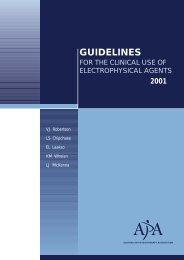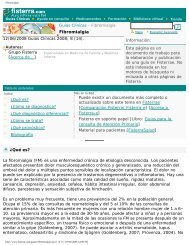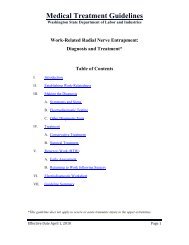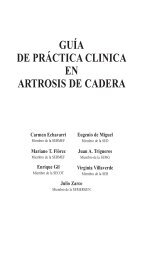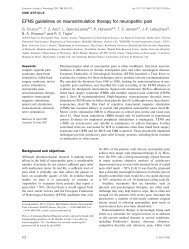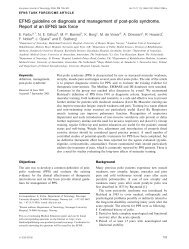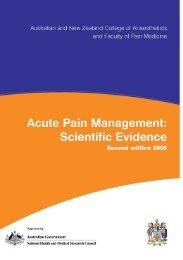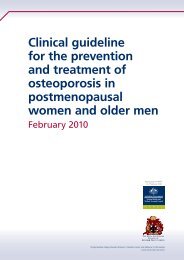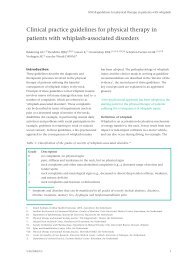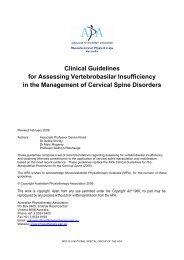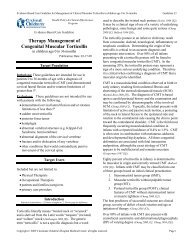Practice Parameter and Literature Review of the Usefulness of ...
Practice Parameter and Literature Review of the Usefulness of ...
Practice Parameter and Literature Review of the Usefulness of ...
Create successful ePaper yourself
Turn your PDF publications into a flip-book with our unique Google optimized e-Paper software.
were (1) carpal tunnel syndrome <strong>and</strong> diagnosis or(2) carpal tunnel syndrome <strong>and</strong> neural conduction.The search generated 497 article titles withabstracts published since 1990. Based on a review<strong>of</strong> <strong>the</strong> abstracts, <strong>the</strong> AAEM CTS Task Force chose92 articles for review. An additional 5 articleswere identified from <strong>the</strong> bibliographies <strong>of</strong> <strong>the</strong>articles, <strong>and</strong> 16 from AAEM members who havecurrent research interests in CTS, for a total <strong>of</strong> 113articles. Of <strong>the</strong> 113 articles reviewed, 24 wereclassified as background references.DESCRIPTION OF THE REVIEWERSIn 1997, <strong>the</strong> AAEM President appointed Dr.Charles K. Jablecki to Chair <strong>the</strong> AAEM CTS TaskForce. The Chair selected <strong>the</strong> members <strong>of</strong> <strong>the</strong>AAEM CTS Task Force from <strong>the</strong> AAEMmembership with <strong>the</strong> assistance <strong>of</strong> <strong>the</strong> AAEM staff<strong>and</strong> <strong>the</strong> AAEM President to include neurologists(Floeter, Jablecki, Wilson) <strong>and</strong> physiatrists(Andary, Quartly, Vennix) in both academic(Andary, Floeter, Quartly, Vennix) <strong>and</strong> clinicalpractice (Jablecki, Wilson) with interests in <strong>the</strong> use<strong>of</strong> EDX studies in CTS. The AAEM CTS TaskForce included three members who authored <strong>the</strong>first CTS <strong>Literature</strong> <strong>Review</strong> published in 1993(Jablecki, Andary, Wilson). In 1999, <strong>the</strong> AAEMPresident appointed Dr. Robert G. Miller to <strong>the</strong>AAEM CTS Task Force to provide an interface<strong>and</strong> full collaboration with <strong>the</strong> AAN QualitySt<strong>and</strong>ards Subcommittee in <strong>the</strong> development <strong>of</strong> <strong>the</strong>second CTS <strong>Literature</strong> <strong>Review</strong> <strong>and</strong> <strong>the</strong> SummaryStatement.LITERATURE INCLUSION CRITERIAIn <strong>the</strong> fall <strong>of</strong> 1991, <strong>the</strong> AAEM Quality AssuranceCommittee adopted six literature inclusion criteria(LIC) <strong>of</strong> scientific methodology to evaluate CTSliterature describing EDX procedures. The AAEMCTS Task Force used <strong>the</strong> same six AAEM CTSLIC when reviewing <strong>the</strong> literature. The first twocriteria apply to all studies <strong>of</strong> diagnostic tests <strong>and</strong>deal with <strong>the</strong> quality <strong>of</strong> evidence <strong>and</strong> reducingbias; <strong>the</strong> remaining four criteria deal with technical<strong>and</strong> analytic issues that are critical to <strong>the</strong> use <strong>of</strong>nerve conduction studies (NCSs) to documentnerve pathology. All <strong>of</strong> <strong>the</strong>se criteria are importantfor a study to determine whe<strong>the</strong>r or not a NCS isuseful to diagnose CTS. The six LIC used were asfollows:1. Prospective study design.2. Diagnosis <strong>of</strong> CTS in patient population basedon clinical criteria independent <strong>of</strong> <strong>the</strong> EDXprocedure under evaluation.3. EDX procedure described in sufficient detailto permit replication <strong>of</strong> <strong>the</strong> procedure.4. Limb temperature monitored (measuredcontinuously) during nerve conductionprocedures <strong>and</strong> minimum (or range) <strong>of</strong> limbtemperatures reported for both CTS patients<strong>and</strong> <strong>the</strong> reference population.5. Reference values for <strong>the</strong> EDX test obtainedei<strong>the</strong>r:a) with concomitant studies <strong>of</strong> a referencepopulation, orb) with previous studies <strong>of</strong> a referencepopulation in <strong>the</strong> same laboratory.6. Criteria for abnormal findings clearly stated<strong>and</strong>, if <strong>the</strong> measurement is a quantitative one,<strong>the</strong> abnormal value is defined in statisticallycomputed terms, e.g., range <strong>and</strong> mean ± 2st<strong>and</strong>ard deviations, from data derived from<strong>the</strong> reference population.REVIEW OF ELECTRODIAGNOSTIC STUDIESA total <strong>of</strong> 22 <strong>of</strong> <strong>the</strong> 278 articles reviewed met all 6AAEM CTS LIC. There were nine additionalarticles (eight using surface electrodes <strong>and</strong> oneusing needle electrodes) that studied median motor<strong>and</strong> sensory nerve conduction across <strong>the</strong> carpaltunnel (amplitude, latency, <strong>and</strong> velocity) in normalsubjects only <strong>and</strong> o<strong>the</strong>rwise fulfilled <strong>the</strong> AAEMCTS LIC.The first <strong>and</strong> second CTS <strong>Literature</strong> <strong>Review</strong>s 1,2provide convincing, scientific evidence thatmedian sensory <strong>and</strong> motor NCSs:1. are valid <strong>and</strong> reproducible clinical laboratorystudies; <strong>and</strong>2. confirm a clinical diagnosis <strong>of</strong> CTS with ahigh degree <strong>of</strong> sensitivity (>85%) <strong>and</strong>specificity (95%).Table 1 provides a summary <strong>of</strong> pooled sensitivities<strong>and</strong> specificities from studies that met all sixAAEM CTS LIC for EDX techniques used todiagnose CTS. In <strong>the</strong>se studies, h<strong>and</strong> temperatureswere monitored continuously <strong>and</strong> <strong>the</strong> majority <strong>of</strong><strong>the</strong> studies maintained <strong>the</strong> h<strong>and</strong> temperature at32°C or greater. Details <strong>of</strong> techniques <strong>and</strong> <strong>the</strong>specific studies pooled are provided in <strong>the</strong> secondCTS <strong>Literature</strong> review. 2DEFINITION OF PRACTICE RECOMMENDATIONSTRENGTHSThe strength <strong>of</strong> a recommendation or conclusion isAAEM <strong>Practice</strong> Topic MUSCLE & NERVE June 2002 919



